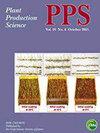Biomass estimation of World rice (Oryza sativa L.) core collection based on the convolutional neural network and digital images of canopy
IF 1.3
3区 农林科学
Q2 AGRONOMY
引用次数: 2
Abstract
ABSTRACT Above-ground biomass (AGB) is an important indicator of crop productivity. Destructive measurements of AGB incur huge costs, and most non-destructive estimations cannot be applied to diverse cultivars having different canopy architectures. This insufficient access to AGB data has potentially limited improvements in crop productivity. Recently, a deep learning technique called convolutional neural network (CNN) has been applied to estimate crop AGB due to its high capacity for digital image recognition. However, the versatility of the CNN-based AGB estimation for diverse cultivars is still unclear. We established and evaluated a CNN-based estimation method for rice AGB using digital images with 59 diverse cultivars which were mostly in World Rice Core Collection. Across two years at two locations, we took 12,183 images of 59 cultivars with commercial digital cameras and manually obtained their corresponding AGB. The CNN model was established by using 28 cultivars and showed high accuracy (R2 = 0.95) to the test dataset. We further evaluated the performance of the CNN model by using 31 cultivars, which were not in the model establishment. The CNN model successfully estimated AGB when the observed AGB was lesser than 924 g m−2 (R2 = 0.87), whereas it underestimated AGB when the observed AGB was greater than 924 g m−2 (R2 = 0.02). This underestimation might be improved by adding training data with a greater AGB in further study. The present study indicates that this CNN-based estimation method is highly versatile and could be a practical tool for monitoring crop AGB in diverse cultivars.基于卷积神经网络和冠层数字图像的世界水稻(Oryza sativa L.)核心生物量估算
摘要地上生物量是衡量作物生产力的重要指标。AGB的破坏性测量产生了巨大的成本,并且大多数非破坏性估计不能应用于具有不同冠层结构的不同品种。AGB数据的获取不足可能限制了作物生产力的提高。最近,一种名为卷积神经网络(CNN)的深度学习技术由于其高的数字图像识别能力而被应用于作物AGB的估计。然而,基于CNN的AGB估计对不同品种的多功能性仍然不清楚。我们使用59个不同品种的数字图像建立并评估了一种基于CNN的水稻AGB估计方法,这些品种大多在世界水稻核心种质中。在两年的时间里,我们在两个地点用商用数码相机拍摄了59个品种的12183张图像,并手动获得了它们相应的AGB。利用28个品种建立了CNN模型,并显示出较高的准确性(R2 = 0.95)到测试数据集。我们使用31个不在模型建立中的品种进一步评估了CNN模型的性能。当观测到的AGB小于924时,CNN模型成功地估计了AGB g m−2(R2 = 0.87),而当观察到的AGB大于924时,它低估了AGB g m−2(R2 = 0.02)。通过在进一步研究中添加具有更大AGB的训练数据,可以改善这种低估。本研究表明,这种基于CNN的估计方法具有高度的通用性,可以成为监测不同品种作物AGB的实用工具。
本文章由计算机程序翻译,如有差异,请以英文原文为准。
求助全文
约1分钟内获得全文
求助全文
来源期刊

Plant Production Science
农林科学-农艺学
CiteScore
5.10
自引率
4.00%
发文量
27
审稿时长
>36 weeks
期刊介绍:
Plant Production Science publishes original research reports on field crops and resource plants, their production and related subjects, covering a wide range of sciences; physiology, biotechnology, morphology, ecology, cropping system, production technology and post harvest management. Studies on plant production with special attention to resource management and the environment are also welcome. Field surveys on cropping or farming system are also accepted. Articles with a background in other research areas such as soil science, meteorology, biometry, product process and plant protection will be accepted as long as they are significantly related to plant production.
 求助内容:
求助内容: 应助结果提醒方式:
应助结果提醒方式:


